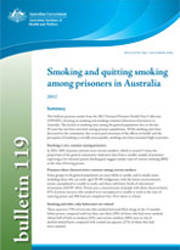Summary
This bulletin presents results from the 2012 National Prisoner Health Data Collection (NPHDC), focusing on smoking and smoking cessation behaviours of prisoners in Australia. The decline in smoking rates among the general population seen in the last 20 years has not been mirrored among prisoner populations. While smoking rates have decreased in the community, due to increased awareness of the effects on health and the perception of smoking as socially unacceptable, moking rates have remained high in prisons.
Smoking is very common among prisoners
In 2012, 84% of prison entrants were current smokers, which is around 5 times the proportion of the general community. Indicative data from a smaller sample of prisoners expecting to be released (prison dischargees) suggest similar rates of current smoking (80%) at the time of leaving prison.
Prisoners share characteristics common among current smokers
Some groups in the general population are more likely to smoke, and to smoke more, including those who are male; aged 20-49; Indigenous; with the lowest socioeconomic status; unemployed or unable to work; and those with lower levels of educational attainment (AIHW 2011). Prison sees a concentration of people with these characteristics: 67% of prison entrants who smoked were unemployed or unable to work at the time of entering prison and 36% had not completed Year 10 or above at school.
Smoking and other risky behaviours are related
Three-quarters (75%) of entrants who smoked had used illicit drugs in the 12 months before prison, compared with less than one-third (29%) of those who had never smoked.
About half of both ex-smokers (51%) and current smokers (48%) were at risk of alcohol-related harm compared with around one-quarter (27%) of those who had never smoked.
Smoking behaviour changes in prison…
While the same proportion (80%) of dischargees reported being a current smoker both at entry to prison and currently, there were some changes in smoking behaviour in prison.
About 1 in 5 (20%) dischargees were ex- or non-smokers, however, 5% who were non-smokers on entry to prison reported that they started smoking while in prison.
One-third of dischargees (33% overall, or 42% of current smokers) reported that they smoked more at exit than they had on entry to prison.
…but few successfully quit
Almost half (46%) of prison entrants who were current smokers expressed a desire to quit smoking, however translating this into successful quit attempts is difficult.
Quitting smoking in prison may be more difficult than in the general community. While 35% of dischargees tried to quit in prison, only 8% successfully quit smoking while in prison, meaning that over one-quarter (27%) of dischargees attempted to quit but were unsuccessful.
Policies on smoking within prisons are changing
In recent years, jurisdictions across Australia have begun to trial or implement restrictions on smoking in prison.



